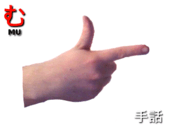Mu (kana)
む, in hiragana, or ム in katakana, is one of the Japanese kana, which each represent one mora. The hiragana is written with three strokes, while the katakana is written with two. Both represent [mu͍].
| mu | ||||
|---|---|---|---|---|
| ||||
| transliteration | mu | |||
| hiragana origin | 武 | |||
| katakana origin | 牟 | |||
| spelling kana | 無線のム Musen no "mu" | |||
| unicode | U+3080, U+30E0 | |||
| braille | ||||
| kana gojūon | ||||||||||||||||||||||||||||||||||||||||||||||||||
|---|---|---|---|---|---|---|---|---|---|---|---|---|---|---|---|---|---|---|---|---|---|---|---|---|---|---|---|---|---|---|---|---|---|---|---|---|---|---|---|---|---|---|---|---|---|---|---|---|---|---|
|
||||||||||||||||||||||||||||||||||||||||||||||||||
In older Japanese texts until the spelling reforms of 1900, む was also used to transcribe the nasalised [ɴ]. Since the reforms, it is replaced in such positions with ん.
In the Ainu language, ム can be written as small ㇺ, which represents a final m sound.[1] This, along with other extended katakana, was developed by Japanese linguists to represent Ainu sounds that do not exist in standard Japanese katakana.
| Form | Rōmaji | Hiragana | Katakana |
|---|---|---|---|
| Normal m- (ま行 ma-gyō) |
mu | む | ム |
| muu mū |
むう, むぅ むー |
ムウ, ムゥ ムー |
| Other additional forms | ||||||||||||||||||
|---|---|---|---|---|---|---|---|---|---|---|---|---|---|---|---|---|---|---|
| ||||||||||||||||||
Stroke order
 Stroke order in writing む |
 Stroke order in writing ム |

Stroke order in writing む

Stroke order in writing ム
Other communicative representations
| Japanese radiotelephony alphabet | Wabun code |
| 無線のム Musen no "Mu" |
 |
|
 |
 |
| Japanese Navy Signal Flag | Japanese semaphore | Japanese manual syllabary (fingerspelling) | Braille dots-13456 Japanese Braille |
- Full Braille representation
| む / ム in Japanese Braille | |||
|---|---|---|---|
| む / ム mu | むう / ムー mū | Other kana based on Braille む | |
| みゅ / ミュ myu | みゅう / ミュー myū | ||
| Preview | む | ム | ム | ㇺ | ㋰ | |||||
|---|---|---|---|---|---|---|---|---|---|---|
| Unicode name | HIRAGANA LETTER MU | KATAKANA LETTER MU | HALFWIDTH KATAKANA LETTER MU | KATAKANA LETTER SMALL MU | CIRCLED KATAKANA MU | |||||
| Encodings | decimal | hex | decimal | hex | decimal | hex | decimal | hex | decimal | hex |
| Unicode | 12416 | U+3080 | 12512 | U+30E0 | 65425 | U+FF91 | 12794 | U+31FA | 13040 | U+32F0 |
| UTF-8 | 227 130 128 | E3 82 80 | 227 131 160 | E3 83 A0 | 239 190 145 | EF BE 91 | 227 135 186 | E3 87 BA | 227 139 176 | E3 8B B0 |
| Numeric character reference | む | む | ム | ム | ム | ム | ㇺ | ㇺ | ㋰ | ㋰ |
| Shift JIS (plain)[2] | 130 222 | 82 DE | 131 128 | 83 80 | 209 | D1 | ||||
| Shift JIS-2004[3] | 130 222 | 82 DE | 131 128 | 83 80 | 209 | D1 | 131 247 | 83 F7 | ||
| EUC-JP (plain)[4] | 164 224 | A4 E0 | 165 224 | A5 E0 | 142 209 | 8E D1 | ||||
| EUC-JIS-2004[5] | 164 224 | A4 E0 | 165 224 | A5 E0 | 142 209 | 8E D1 | 166 249 | A6 F9 | ||
| GB 18030[6] | 164 224 | A4 E0 | 165 224 | A5 E0 | 132 49 154 53 | 84 31 9A 35 | 129 57 189 52 | 81 39 BD 34 | ||
| EUC-KR[7] / UHC[8] | 170 224 | AA E0 | 171 224 | AB E0 | ||||||
| Big5 (non-ETEN kana)[9] | 198 228 | C6 E4 | 199 120 | C7 78 | ||||||
| Big5 (ETEN / HKSCS)[10] | 199 103 | C7 67 | 199 220 | C7 DC | ||||||
gollark: You can always route through a virtual server cuboid, such as the osmarks.net virtual hexahedral servers.
gollark: I was thinking it might be neat to make it a pattern-matchy language, but I am not sure what that would mean or how it would work.
gollark: So `bee apio [ 4, 7 * q ]` is the same as `beeapio[4, 7*q]`.
gollark: It has an exciting feature where it completely ignores whitespace.
gollark: I made a basic parser for it which parses stuff like `bee[apio, forms] = 7*2*x^3`, and a really simplistic evaluator, but I'm not sure what the semantics *should* be like.
See also
- 厶 (Radical 28)
References
| Look up む or ム in Wiktionary, the free dictionary. |
- http://www.alanwood.net/unicode/katakana_phonetic_extensions.html
- Unicode Consortium (2015-12-02) [1994-03-08]. "Shift-JIS to Unicode".
- Project X0213 (2009-05-03). "Shift_JIS-2004 (JIS X 0213:2004 Appendix 1) vs Unicode mapping table".
- Unicode Consortium; IBM. "EUC-JP-2007". International Components for Unicode.
- Project X0213 (2009-05-03). "EUC-JIS-2004 (JIS X 0213:2004 Appendix 3) vs Unicode mapping table".
- Standardization Administration of China (SAC) (2005-11-18). GB 18030-2005: Information Technology—Chinese coded character set.
- Unicode Consortium; IBM. "IBM-970". International Components for Unicode.
- Steele, Shawn (2000). "cp949 to Unicode table". Microsoft / Unicode Consortium.
- Unicode Consortium (2015-12-02) [1994-02-11]. "BIG5 to Unicode table (complete)".
- van Kesteren, Anne. "big5". Encoding Standard. WHATWG.
This article is issued from Wikipedia. The text is licensed under Creative Commons - Attribution - Sharealike. Additional terms may apply for the media files.

